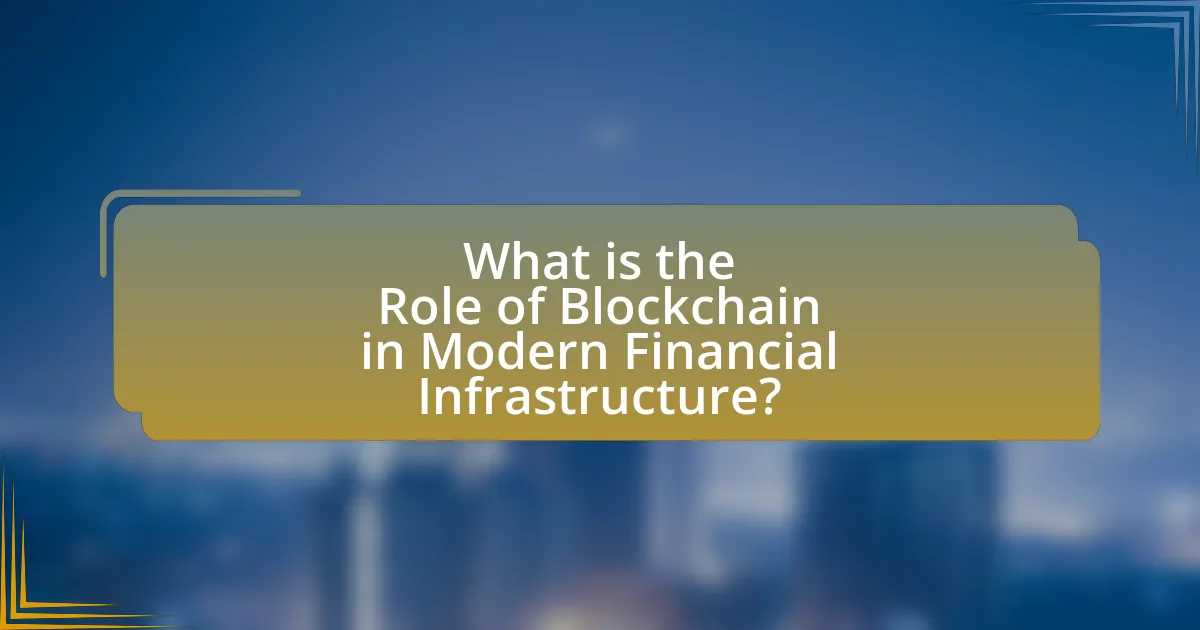Blockchain is a decentralized technology that plays a pivotal role in modern financial infrastructure by enhancing security, transparency, and efficiency in transaction processing. It operates through a public ledger that records transactions immutably, reducing fraud and the need for intermediaries, which can lead to significant cost savings. Key components of blockchain, such as consensus mechanisms and smart contracts, facilitate real-time verification and automation of transactions. Despite its advantages, blockchain faces challenges including scalability, regulatory compliance, and interoperability, which impact its widespread adoption in the financial sector. The article explores these aspects, highlighting how blockchain is transforming traditional financial services and shaping the future of digital currencies.

What is the Role of Blockchain in Modern Financial Infrastructure?
Blockchain plays a crucial role in modern financial infrastructure by providing a decentralized and secure method for recording transactions. This technology enhances transparency and reduces fraud, as each transaction is recorded on a public ledger that is immutable and accessible to all participants. For instance, according to a report by the World Economic Forum, blockchain could reduce financial transaction costs by up to 30% by streamlining processes and eliminating intermediaries. Additionally, blockchain facilitates faster cross-border payments, with some platforms enabling transactions in minutes compared to traditional methods that can take days. Overall, blockchain’s ability to enhance security, efficiency, and transparency positions it as a transformative force in the financial sector.
How does blockchain technology function within financial systems?
Blockchain technology functions within financial systems by providing a decentralized and secure method for recording transactions. This technology enables multiple parties to access and verify transaction data in real-time, reducing the need for intermediaries such as banks. Each transaction is recorded in a block, which is then linked to previous blocks, creating an immutable chain of records. This structure enhances transparency and trust among participants, as all changes are visible and verifiable.
Moreover, blockchain’s consensus mechanisms, such as proof of work or proof of stake, ensure that all parties agree on the validity of transactions before they are added to the ledger. This reduces the risk of fraud and enhances security. According to a report by the World Economic Forum, blockchain could potentially reduce financial transaction costs by up to 50% by streamlining processes and eliminating intermediaries.
What are the key components of blockchain technology?
The key components of blockchain technology are decentralization, transparency, security, consensus mechanisms, and smart contracts. Decentralization ensures that no single entity controls the entire network, which enhances resilience and reduces the risk of failure. Transparency allows all participants to view transaction histories, fostering trust among users. Security is achieved through cryptographic techniques that protect data integrity and prevent unauthorized access. Consensus mechanisms, such as Proof of Work or Proof of Stake, enable agreement among network participants on the validity of transactions. Smart contracts automate and enforce agreements without intermediaries, streamlining processes and reducing costs. These components collectively contribute to the effectiveness and reliability of blockchain in modern financial infrastructure.
How do these components interact to facilitate transactions?
Blockchain components, including nodes, ledgers, and smart contracts, interact to facilitate transactions by ensuring transparency, security, and automation. Nodes validate and propagate transaction data across the network, while the distributed ledger maintains a tamper-proof record of all transactions. Smart contracts automate execution based on predefined conditions, reducing the need for intermediaries. This interaction enhances transaction efficiency and trust, as evidenced by the increased adoption of blockchain in financial services, which has led to faster settlement times and reduced costs.
What are the primary benefits of integrating blockchain into financial infrastructure?
Integrating blockchain into financial infrastructure primarily enhances security, transparency, and efficiency. Blockchain technology employs cryptographic techniques that secure transactions, making it nearly impossible to alter data without consensus from the network. This high level of security reduces fraud and increases trust among participants.
Moreover, blockchain provides a transparent ledger that allows all parties to view transaction histories in real-time, fostering accountability and reducing disputes. According to a report by the World Economic Forum, blockchain could reduce the costs of cross-border payments by up to 80%, demonstrating its potential to streamline processes and lower operational costs.
Additionally, the decentralized nature of blockchain eliminates the need for intermediaries, which accelerates transaction times and reduces fees. This combination of benefits positions blockchain as a transformative force in modern financial infrastructure.
How does blockchain enhance security in financial transactions?
Blockchain enhances security in financial transactions by providing a decentralized and immutable ledger that records all transaction data transparently. This technology ensures that once a transaction is recorded, it cannot be altered or deleted, significantly reducing the risk of fraud and unauthorized access. The use of cryptographic techniques, such as hashing and digital signatures, further secures the data, ensuring that only authorized parties can initiate or verify transactions. According to a report by the World Economic Forum, blockchain technology can reduce fraud in financial transactions by up to 80%, demonstrating its effectiveness in enhancing security within the financial sector.
What cost savings can blockchain provide to financial institutions?
Blockchain can provide significant cost savings to financial institutions by reducing transaction fees, streamlining processes, and minimizing fraud. By enabling peer-to-peer transactions without intermediaries, blockchain technology can lower costs associated with traditional banking services, such as wire transfers and cross-border payments, which can incur fees ranging from 2% to 5%. Additionally, blockchain automates and accelerates processes like settlement and reconciliation, which traditionally require extensive manual intervention and can take days to complete. A study by Accenture found that blockchain could save banks up to $20 billion annually by 2022 through these efficiencies. Furthermore, the enhanced security features of blockchain reduce the risk of fraud, which can cost financial institutions billions each year. Thus, the integration of blockchain technology can lead to substantial financial benefits for these institutions.
What challenges does blockchain face in modern financial infrastructure?
Blockchain faces several challenges in modern financial infrastructure, including scalability, regulatory compliance, and interoperability. Scalability issues arise as blockchain networks struggle to handle a high volume of transactions efficiently; for instance, Bitcoin can process only about 7 transactions per second, compared to Visa’s capacity of over 24,000. Regulatory compliance presents a challenge as governments worldwide grapple with how to regulate blockchain technology, leading to uncertainty for businesses operating in this space. Additionally, interoperability between different blockchain systems remains limited, hindering seamless transactions across various platforms. These challenges collectively impede the widespread adoption of blockchain in the financial sector.
How do regulatory concerns impact blockchain adoption?
Regulatory concerns significantly hinder blockchain adoption by creating uncertainty and compliance challenges for businesses. Companies often face difficulties in navigating varying regulations across jurisdictions, which can lead to increased operational costs and delays in implementation. For instance, the Financial Action Task Force (FATF) guidelines on anti-money laundering (AML) and combating the financing of terrorism (CFT) require blockchain platforms to implement stringent Know Your Customer (KYC) processes, which can deter innovation and limit user participation. Additionally, regulatory scrutiny can lead to a lack of investment in blockchain projects, as investors may be wary of potential legal repercussions. This cautious approach is evident in the slow pace of regulatory frameworks being established globally, which further complicates the landscape for blockchain technology adoption.
What technological limitations exist for blockchain in finance?
Blockchain in finance faces several technological limitations, including scalability, energy consumption, and regulatory compliance challenges. Scalability issues arise because many blockchain networks struggle to process a high volume of transactions quickly; for instance, Bitcoin can handle approximately 7 transactions per second, while traditional payment systems like Visa can process over 24,000 transactions per second. Energy consumption is another significant limitation, as the proof-of-work consensus mechanism used by many blockchains requires substantial computational power, leading to environmental concerns. Additionally, regulatory compliance poses challenges, as the decentralized nature of blockchain can conflict with existing financial regulations, making it difficult for institutions to adopt blockchain solutions without clear legal frameworks. These limitations hinder the widespread adoption of blockchain technology in the financial sector.
How is blockchain transforming traditional financial services?
Blockchain is transforming traditional financial services by enhancing transparency, reducing costs, and increasing transaction speed. Financial institutions are adopting blockchain technology to streamline processes such as cross-border payments, which can take days and incur high fees; blockchain can facilitate these transactions in minutes with significantly lower costs. For instance, a study by the World Economic Forum indicates that blockchain could reduce banks’ infrastructure costs by up to $20 billion annually by 2022. Additionally, blockchain’s decentralized nature minimizes fraud risks and enhances security, as transactions are recorded on an immutable ledger accessible to all parties involved. This transformation is evident in the rise of decentralized finance (DeFi) platforms, which offer services like lending and trading without traditional intermediaries, further illustrating blockchain’s impact on the financial landscape.
What new financial products are emerging from blockchain technology?
New financial products emerging from blockchain technology include decentralized finance (DeFi) platforms, non-fungible tokens (NFTs), and central bank digital currencies (CBDCs). DeFi platforms enable users to lend, borrow, and trade assets without intermediaries, exemplified by protocols like Aave and Uniswap, which have collectively locked billions in assets. NFTs represent ownership of unique digital items and have gained traction in art and gaming, with sales reaching over $10 billion in 2021 alone. CBDCs are being explored by various governments, including China’s digital yuan, which aims to modernize payment systems and enhance monetary policy. These innovations demonstrate blockchain’s transformative impact on the financial landscape.
How are banks adapting to the rise of blockchain solutions?
Banks are adapting to the rise of blockchain solutions by integrating this technology into their operations to enhance efficiency, security, and transparency. Many financial institutions are exploring partnerships with blockchain startups and investing in research and development to create blockchain-based products, such as digital currencies and smart contracts. For instance, JPMorgan Chase launched its own blockchain network, Quorum, to facilitate secure transactions and improve data sharing. Additionally, a report by the World Economic Forum indicates that 10% of global GDP could be stored on blockchain by 2027, highlighting the urgency for banks to innovate and remain competitive in a rapidly evolving financial landscape.
What are the future trends of blockchain in financial infrastructure?
Future trends of blockchain in financial infrastructure include increased adoption of decentralized finance (DeFi), enhanced security through smart contracts, and the integration of central bank digital currencies (CBDCs). DeFi platforms are projected to grow significantly, with the total value locked in DeFi exceeding $200 billion in 2021, indicating a shift towards peer-to-peer financial services. Smart contracts are expected to streamline transactions and reduce fraud, as they automate processes and enforce agreements without intermediaries. Additionally, several central banks are exploring or piloting CBDCs, with countries like China and Sweden leading the way, which could reshape monetary policy and cross-border payments. These trends highlight blockchain’s potential to revolutionize financial systems by improving efficiency, transparency, and accessibility.
How might blockchain influence the evolution of digital currencies?
Blockchain technology is likely to significantly influence the evolution of digital currencies by providing enhanced security, transparency, and efficiency in transactions. The decentralized nature of blockchain eliminates the need for intermediaries, reducing transaction costs and time. For instance, Bitcoin, the first digital currency, utilizes blockchain to enable peer-to-peer transactions without a central authority, demonstrating how blockchain can facilitate direct exchanges. Additionally, the immutable ledger feature of blockchain ensures that transaction records are tamper-proof, which increases trust among users. According to a report by the World Economic Forum, by 2025, 10% of global GDP could be stored on blockchain technology, highlighting its potential impact on the financial landscape and the future of digital currencies.
What role will smart contracts play in future financial transactions?
Smart contracts will automate and streamline future financial transactions by executing predefined agreements without intermediaries. This automation reduces the need for trust in third parties, minimizes transaction costs, and enhances efficiency. According to a report by the World Economic Forum, smart contracts could save the financial services industry up to $20 billion annually by 2022 through increased efficiency and reduced fraud. Additionally, smart contracts enable real-time settlement of transactions, which can significantly improve liquidity and reduce counterparty risk.
What best practices should financial institutions consider when implementing blockchain?
Financial institutions should prioritize security, regulatory compliance, and interoperability when implementing blockchain. Security is crucial as blockchain systems can be vulnerable to cyberattacks; therefore, employing robust encryption and multi-signature protocols is essential. Regulatory compliance ensures that institutions adhere to legal frameworks, which can vary significantly across jurisdictions, thus necessitating a thorough understanding of applicable laws and regulations. Interoperability is vital for seamless integration with existing systems and other blockchain networks, enabling efficient data exchange and collaboration. According to a report by the World Economic Forum, 10% of global GDP could be stored on blockchain by 2027, highlighting the importance of these best practices for successful implementation.


